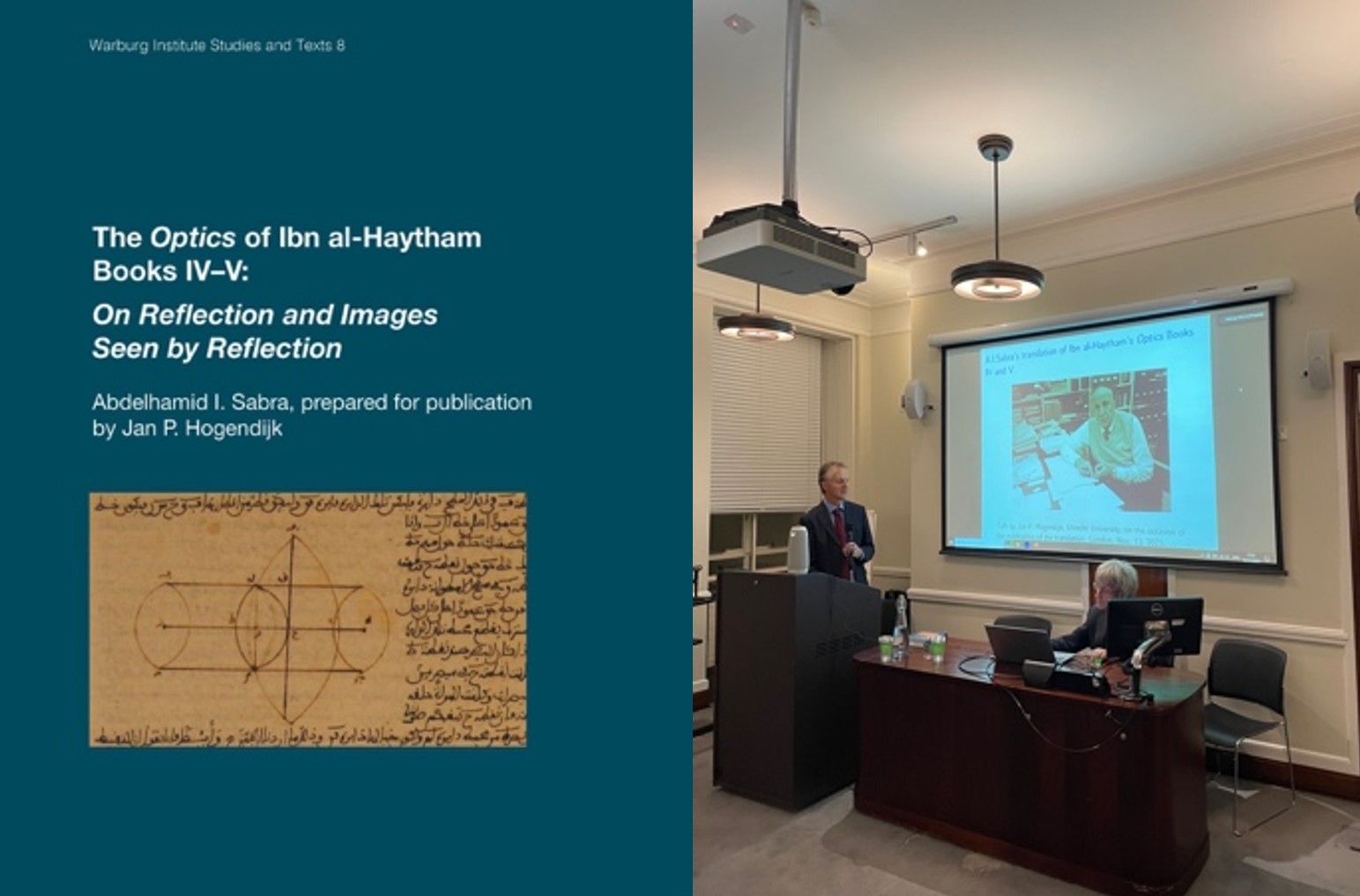On Monday 13 November 2023, a book launch was hosted by the Warburg Institute, London, for The Optics of Ibn al-Haytham Books IV-V: On Reflection and Images Seen by Reflection, translated by Abdelhamid I. Sabra and published by the Warburg Institute with the University of London Press, with the generous support of the Foundation for Science, Technology and Civilisation (UK). The work was prepared for publication by Jan P. Hogendijk, a leading expert in Arabic mathematics. This short article is an outline of the launch event.
The Optics of Ibn al-Haytham Books IV-V translated by Abdelhamid I. Sabra, London, 2023 and Charles Burnett, Warburg Institute, University of London


Figure 1. Professor Jan Hogendijk (left), Prof. Charles Burnett (right) and late Prof. A. I Sabra on the screen
On Monday 13 November 2023, a book launch was hosted by the Warburg Institute, London, for The Optics of Ibn al-Haytham Books IV-V: On Reflection and Images Seen by Reflection, translated by Abdelhamid I. Sabra and published by the Warburg Institute with the University of London Press, with the generous support of the Foundation for Science, Technology and Civilisation (UK). The work was prepared for publication by Jan P. Hogendijk, a leading expert in Arabic mathematics. The Optics (kitāb al-Manāẓir or Perspectiva/De aspectibus of Abū ʿAlī ibn al-Haytham al-Ḥasan ibn al-Ḥasan, ca. 965-1040) is one of the foundational works in the history of science. It was written between 1028 and 1038 in Cairo and had a distribution in the Islamicate world, and even more so in Western Christendom, after its translation into Latin in the late 12th or early 13th century under the name ‘Alhazen’ or ‘Alhacen’. Its seven books treat of the function of the eye, direct vision, reflection and images seen by reflection-refracted light and false images. Sabra’s project was to edit and translate the whole seven books, but at the time of his death in 2013, he had published only the Arabic of the first five books, and an English translation, with commentary, of the first three books. He left a translation of books IV and V, and this was the basis of a thorough revision by Jan Hogendijk, who added the correspondences to Mark Smith’s edition and translation of the Latin text. The Warburg Institute was the obvious place for this revised translation to be published, given that Sabra had been a Fellow and then a member of its teaching staff from 1962 to 1972. In an unpublished letter to the Director of the time he pointed to ‘the real interest in the historical role of the Optics which’ he ‘quickly discovered among members of the Institute’s faculty’, and it was at the Warburg Institute that he laid the foundations for his edition and translation.
The large attendance at the book launch, in person and online, attested to a more general interest in the book.


Figure 2. Prof. Charles Burnett
Introduction by Prof. Charles Burnett
After Charles Burnett’s introduction, in which all those who had contributed to the successful publishing of the book were mentioned, Elaheh Kheirandish, a PhD student of Sabra and currently at the Classics Department and Center for Hellenic Studies of Harvard University, talked about her direct experience of ‘Bashi’ Sabra as a scholar and a kind and supportive friend.


Figure 3. Dr Elaheh Kheirandish
Dr Elaheh Kheirandish
Jan Hogendijk told us what needed to be done to prepare Sabra’s translation for publication. Saira Malik, a senior lecturer at Cardiff University, summarised the three kinds of optics in the Islamic world – anatomical, physical and geometrical – and showed how Ibn al-Haytham’s Optics dealt especially with the anatomical and geometrical kinds.


Figure 4. Dr Saira Malik
Dr Saira Malik
Finally, Nader El-Bizri (online), the Dean of the College of Arts, Humanities, and Social Sciences at the University of Sharjah, gave a well-illustrated history of the Optics in the West and the dominant role Ibn al-Haytham played in this history.


Figure 5. Dr. Nader El-Bizri
Dr. Nader El-Bizri (online)
The event ended with a lively discussion about Sabra, Ibn al-Haytham and optics, accompanied by drinks and snacks. The Warburg Institute and the Foundation for Science, Technology and Civilisation (UK) contributed to the launch success.


Figure 6. Honouring overseas speakers (From left): Jan Hogendijk, Charles Burnett, Elaheh , Kheirandish,
Peter Fell, Anne-Maria Brennan and Hormoz Goodarzy
5 / 5. Votes 1
No votes so far! Be the first to rate this post.


Muslim Heritage:
Send us your e-mail address to be informed about our work.
This Website MuslimHeritage.com is owned by FSTC Ltd and managed by the Foundation for Science, Technology and Civilisation, UK (FSTCUK), a British charity number 1158509.
© Copyright FSTC Ltd 2002-2020. All Rights Reserved.
